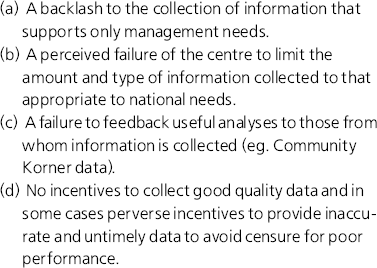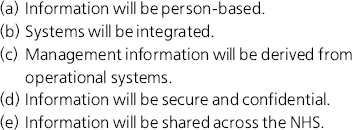What follows is an attempt to summarise the current national approach to the management of information in mental health services. There are many different perspectives — mine is that of a member of the College Informatics Sub-Committee and lead psychiatrist for the NHS Information Authority.
Information for Health (NHS Executive, 1998) sets the broad agenda for the NHS until 2005, and mental health trusts are already implementing the guidance documents that followed, particularly in drafting trust and local implementation strategies. More recently the Mental Health National Service Framework (NSF; Department of Health, 1999) provided standards and service models, and referred to several existing information projects and a number of performance indicators. These do not in themselves constitute a complete information strategy, since their piecemeal origination has meant that they are not always compatible or comprehensive. The Mental Health Information Strategy (MH–IS) will guide local organisations towards specific informatics developments that will improve clinical services in the manner described in the NSF and other policy documents.
Why a strategy specific to mental health?
Some of the problems that mental health services have in managing information are common to all NHS units (see Box 1). In addition, the fact that our services operate as multi-site networks integrating care of individuals across management boundaries makes for greater complexity in data structures, software applications and electronic communications. But reliable flow of both clinical and management information between social care agencies, health services, voluntary organisations and law enforcement and criminal justice systems is essential on an everyday basis. Mental health trusts and social services departments tend to have a small voice compared to bigger organisations, such as general hospitals and primary care groups. Furthermore, the lack of a sufficiently detailed national overview on mental health information issues has left many units with unacceptable risks in the implementation process.
Box 1. Problems of information management in mental health services (from Information for Health, NHS Executive, 1998)

| (a) A backlash to the collection of information that supports only management needs. |
| (b) A perceived failure of the centre to limit the amount and type of information collected to that appropriate to national needs. |
| (c) A failure to feedback useful analyses to those from whom information is collected (eg. Community Korner data). |
| (d) No incentives to collect good quality data and in some cases perverse incentives to provide inaccurate and untimely data to avoid censure for poor performance. |
All these factors have led to a slow pace of development, lack of financial commitment, wastage of public funds in some local initiatives and exhausted ‘champions’ in others.
Types of information to be considered
The NSF separates three classes of information.
The knowledge base for patients, carers and the public includes information about mental health issues, types of treatment, how to access services, performance indicators, etc. For clinicians and managers it includes printed and electronic reference material, clinical guidelines, research and audit results, expert systems, etc.
Patient-based information for clinical care contains patient records, electronic records and raw data on clinical activities and resource inputs that are related to the clinical process.
Derived information for managing, planning and monitoring services comprises aggregated and anonymised clinical data, and financial, outcomes, resourcing and public health information. The same data can be analysed in different ways (if it is of good quality, reliable, valid and appropriately grouped) for clinical governance, the National Framework for Assessing Performance, health improvement programmes and of course the NSF itself.
It is useful to distinguish between text, which conveys detailed, context-sensitive information about a single subject, and standardised coded data, which can be aggregated for communications about groups of subjects. Top-down approaches to information strategy have tended to overemphasise coded data and derived information, hence their unpopularity with clinicians.
The work to be done
Principles for the MH-IS must include those for parent organisations, particularly the NHS (see Box 2). A further principle should be that each clinician's effort of data collection is rewarded by returned information, or some demonstration that the data have been used.
Box 2. Principles governing health information strategies (from Information for Health, NHS Executive, 1998)

| (a) Information will be person-based. |
| (b) Systems will be integrated. |
| (c) Management information will be derived from operational systems. |
| (d) Information will be secure and confidential. |
| (e) Information will be shared across the NHS. |
A few of the many areas that need to be developed are listed below.
Electronic patient records (EPR)
An early challenge will be to devise an EPR structure that contains enough standardised data items, yet also allows the freedom for adaptation to local needs and initiatives — probably within the NHS-wide headings suggested by Severs et al (cited in NHS Information Authority, 1999a ). In some medical specialities the goal will be to replace all ‘buff folders’ with electronic records, but this seems unachievable for mental health services in the short term. The EPR will be structured to enable some information to be ‘pushed’ routinely to primary care systems to form part of each patient's lifelong electronic health record, as well as allowing access for all those with an authorised need to know to ‘pull’ required information. It may be advantageous to determine nationally which items should be ‘pushed’ and which ‘pulled’, since there are predictable tensions between primary health care teams (arguing for greater availability, but lacking safeguards) and mental health units (the guardians of much confidential information). There may also be a need for a nationally defined minimum ‘push’ data-set. The EPR will provide standardised data for planning, commissioning and monitoring services, from local team to national level.
Standard data
Coded ‘clinical terms’ are the building blocks from which more complex items such as the NSF indicators and probably the EPR will be compiled, but the collaboration between the Centre for Coding and Classification (Read Codes) and SNOMED (NHS Information Authority, 1999b ) presently has no designated mental health project.
Sharing information
Sharing NHS information with social services and other agencies will not improve rapidly unless a national development strategy can be devised. Sharing of prescribing information between psychiatrists, general practitioners, acute hospitals and pharmacies would be highly advantageous. Drug information might be one of the automatic ‘push’ items from EPRs.
Health improvement programmes and population needs assessments must be supported by a wider range of standard data, but that will not be collected without a national mandate.
Integrating disparate lines of development
A meeting organised by the NHS Information Authority Casemix Programme in December 1999 brought together a number of key projects (with separate aims and origins) with staff from the Information Policy Unit and Health Services Directorate 4 of the Department of Health. We hoped that the MH-IS would establish a programme to assemble this jigsaw, without stifling local initiatives. There is no space here to review projects, but minutes of the meeting and references for each project are available at the Casemix Programme website (http://www.casemix.nhsia.nhs.uk).
Training and staff support
Most clinicians need informatics training (Reference TurnerNHS Executive, 1999). Recent graduates are more comfortable than those with greater clinical experience when using computers, but technical skill is not synonymous with the ability to produce valuable output, which requires an understanding of context. It is likely that training will be as much a rate-limiting step as is the provision of computers in exploiting the possibilities that the new technology will bring.
Implementation and development
Examples of good informatics practice need to be published, but paper journals are too slow for the purpose and editors are often disinclined to accept such material. ‘Gateway sites’ will therefore be needed, which can be used to access up-to-date accounts using browser technology.
How will informatics alter mental healthcare?
For patients and the public, there will be improved access to paper and electronic information about mental health and services. Other innovations might include: a single gateway to accredited information on the internet, and training for long-term patients in how to use it; shorter waiting times, thanks to electronic referral and transfer systems; ‘Telecare’, such as NHS Direct, for telephone counselling; and patient-held information, for instance on smart cards, which could be assembled by keyworkers — this might include Care Programme Approach details, relevant health education, drug information, suggested strategies, relapse warning signs, appointment details, etc.
Clinicians can expect routinely to collect and use data on conditions, interventions and clinical outcomes. ‘Real time’ information about patients will be more available out of hours and off-site through the use of portable (eg. wireless) devices in communication with central patient information systems. Electronic referrals and requests will result in less need to repeat the same information on different forms and documents. There will be rapid and reliable access to the knowledge base, including clinical guidelines, decision support and expert systems, computer-based training packages, self-evaluation and audit tools, etc. Alternatives to keyboards, such as voice recognition, may make it realistic for clinicians to enter data directly.
Clinical managers in both community teams and hospitals will be able to practise evidence-based management, by analysing case-load and case-mix, the interventions provided and comparative clinical outcomes. Activity data, such as the number of hospital episodes and community contacts (overemphasised in the old way of doing things), will still need to be recorded, but they are measures of ‘process’ rather than ‘output’ and should be used within provider units rather than to determine service agreements.
Primary care groups/trusts will be able to see the broader picture, including prescribing and the use of psychological interventions in both secondary and primary care.
Health authorities will be able to publish information about services, using the same methods of grouping and aggregation employed for internal NHS purposes. The National Framework for Assessing Performance will provide the means for benchmarking information using credible and reliable measures, including data quality and the NSF indicators. Health improvement programmes will be based increasingly on local information, compared against national norms.
The rational distribution of resources between areas will become possible when the range and quality of derived information is improved. Population health surveys are not a practical means of determining mental health needs, and needs estimates based on census data algorithms such as the York Index, although much easier to carry out, are presently inaccurate and can be misleading (NHS Information Authority, 1999c ). There is a particular lack of relevant community data. New socio-economic area statistics will be available following the 2001 census, and with an improved minimum data-set it might then be possible to look further than ‘normalising’ the supply of services to deprived areas (by increasing resources to match an expected high throughput), to actually reducing the prevalence of recurrent mental health problems in people living in less affluent areas.
How will the MH-IS be set up?
Mental health units have been hindered by not knowing the information that will be required of them. More detailed guidance will make them more willing to commit resources to the three essentials: information systems, training and technical support.
A draft MH-IS is due to be released for consultation during the summer of this year and should be available from trust and health authority leads. This represents a valuable opportunity to influence something about which there has been much complaint in the past. Individual psychiatrists may make their own comments directly through their trust, or through the College Informatics Sub-Committee. Progress is to be posted on the Information Policy Unit website (http://www.don.gov.uk/nhsexipu/).
Finally, it has to be said that the need for a coordinated national strategy has been recognised — by some at least — for many years: “One task that is essential and desirable at this relatively early stage is that the considerable developmental work that has gone into all the systems is taken greatest advantage of through the development of an integrated strategic approach.” (Reference ShanksShanks, 1992) Hopefully, this long gestation within the Department of Health will be worthwhile.





eLetters
No eLetters have been published for this article.